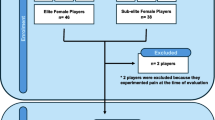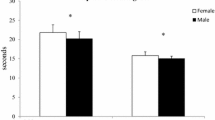Abstract
This study aimed to clarify the differences in the cross-sectional area (CSA) of the psoas major (PM) muscle and hip flexion force (HFF) of the right (dominant) side between adolescent male soccer players and age-matched non-athletes. PM CSA at L4–L5 and HFF at 1.05 rad/s were determined in 22 early (12.8–13.6 years) and 27 late (16.1–17.9 years) adolescent soccer players and 11 early (12.6–13.5 years) and 20 late (16.0–17.7 years) adolescent non-athletes. Fat-free mass (FFM) was greater in late adolescent soccer players than in late adolescent non-athletes, but was similar between the two early adolescent groups. Without the effect of age, PM CSA and HFF were greater in soccer players than in non-athletes. PM CSA and HFF were significantly correlated to FFM (soccer players, r = 0.860, P < 0.0001; non-athletes, r = 0.709, P < 0.0001) and PM CSA (soccer players, r = 0.760, P < 0.0001; non-athletes, r = 0.777, P < 0.0001), respectively. The difference between soccer players and non-athletes in PM CSA was still significant even when PM CSA was covaried for FFM. On the other hand, HFF covaried for PM CSA was similar between the two groups. The current results indicate that, as compared to age-matched non-athletes: (1) not only late, but also early adolescent soccer players have a greater PM CSA even when the difference in FFM was adjusted, and (2) their superiority in hip flexion force can be attributed to the difference in PM CSA.


Similar content being viewed by others
References
Andersson E, Oddsson L, Grundstrom H, Thorstensson A (1995) The role of the psoas and iliacus muscles for stability and movement of the lumber spine, pelvis and hip. Scand J Med Sci Sports 5:10–16
Andersson EA, Nilsson J, Thorstensson A (1997) Intramuscular EMG from the hip flexor muscles during human locomotion. Acta Physiol Scand 161:361–370
Arbanas J, Starcevic K, Nikolic M, Jerkovic R, Miljanovic I, Malnar D (2009) Fibre type composition of the human psoas major muscle with regard to the level of its origin. J Anat 215:636–641
Bogduk N, Pearcy M, Hadfield G (1992) Anatomy and biomechanics of psoas major. Clin Biomech 7:109–115
Brožek J, Grande F, Anderson JT, Keys A (1963) Densitmetric analysis of body composition: revision and some quantitative assumption. Ann N Y Acad Sci 110:113–140
Delecluse C (1997) Influence of strength training on sprint running performance. Sports Med 24:147–156
Dempster P, Aitkens S (1995) A new air displacement method for the determination of human body composition. Med Sci Sports Exerc 27:1692–1697
Eliakim A, Scheett T, Allmendinger N, Brasel JA, Cooper DM (2001) Training, muscle volume, and energy expenditure in nonobese American girls. J Appl Physiol 90:35–44
Fukunaga T, Funato K, Ikegawa S (1992) The effects of resistance training on musclearea and strength in prepubescent age. Ann Physiol Anthropol 11:357–364
Gerbino PG, Griffin ED, Zurakowski D (2007) Comparison of standing balance between female collegiate dancer and soccer players. Gait Posture 26:501–507
Hoshikawa Y, Muramatsu M, Iida T, Uchiyama A, Nakajima Y, Kanehisa H, Fukunaga T (2006) Influence of the psoas major and thigh muscularity on 100-m times in junior sprinters. Med Sci Sports Exerc 38:2138–2143
Hoshikawa Y, Iida T, Muramatsu M, Nakajima Y, Fukunaga T, Kanehisa H (2009) Differences in thigh muscularity and dynamic torque between junior and senior soccer players. J Sports Sci 27:129–138
Hoshikawa Y, Muramatsu M, Iida T, Uchiyama A, Nakajima Y, Kanhiesa H (2010) Event-related differences in the cross-sectional areas and torque generation capabilities of quadriceps femoris and hamstrings in male high school athletes. J Physiol Anthropol 29:13–21
Hoshikawa Y, Muramatsu M, Iida T, Ii N, Nakajima Y, Kanehisa H (2011) Sex difference in the cross-sectional areas of psoas major and thigh muscles in high school track and field athletes and nonathletes. J Physiol Anthropol 30:47–53
Hu H, Meijer OG, van Dieen JH, Hodges PW, Bruijn SM, Strijers RL, Nanayakkara PWB, van Royen BJ, Wu WH, Xia C (2011) Is the psoas a hip flexor in the active straight leg raise? Eur Spine J 20:759–765
Ishiguro N, Kanhisa H, Miyatani M, Masuo Y, Fukunaga T (2005) A comparison of three bioelectrical impedance analyses for predicting lean body mass in a population with large difference in muscularity. Eur J Appl Physiol 94:25–35
Kanehisa H, Fukunaga T (1999) Profiles of musculo-skeletal development in limbs of college Olympic weightlifters and wrestlers. Eur J Appl Physiol 79:414–420
Kanehisa H, Ikegawa S, Fukunaga T (1998) Comparison of muscle cross-sectional areas between weight lifters and wrestlers. Int J Sports Med 19:265–271
Kellis E, Katis A (2007) The relationship between isokinetic knee extension and flexion strength with soccer kick kinematics: an electromyographic evaluation. J Sports Med Phys Fitness 47:385–394
Kubo T, Muramatsu M, Hoshikawa Y, Kanehisa H (2010) Profiles of trunk and thigh muscularity in youth and professional soccer players. J Strength Con Res 24:1472–1479
Lesmes GR, Costill DL, Coyle EF, Fink WJ (1978) Muscle strength and power changes during maximal isokinetic training. Med Sci Sports 10:266–269
Maffulli N, King JB, Helms P (1994) Training in elite young athletes (the training of young athletes (TOYA) study): injuries, flexibility and isometric strength. Br J Sports Med 28:123–136
Mann RA, Morgan GT, Dougherty SE (1986) Comparative electromyography of the lower extremity in jogging, running, and sprinting. Am J Sports Med 14:501–510
Masuda K, Kikuhara N, Takahashi H, Yamanaka K (2003) The relationship between muscle cross-sectional area and strength in various isokinetic movements among soccer players. J Sports Sci 21:851–858
Mero A, Komi PV, Gregor RJ (1992) Biomechanics of sprint running: a review. Sports Med 13:376–392
Mognoni P, Narici MV, Sirtori MD, Lorenzelli F (1994) Isokinetic torques and kicking maximal ball velocity in young soccer players. J Sports Med Phys Fitness 34:357–361
Nilsson J, Thorstensson A, Halbertsma J (1985) Changes in leg movements and muscle activity with speed of locomotion and mode of progression in humans. Acta Physiol Scand 123:457–475
Nunome H, Asai T, Ikegami Y, Sakurai S (2002) Three-dimensional kinetic analysis of side-foot and instep soccer kicks. Med Sci Sports Exerc 34:2028–2036
Osternig LR (1986) Isokinetic dynamometry: implication for muscle testing and rehabilitation. Exerc Sports Sci Rev 14:45–80
Peltonen JE, Taimela S, Erkintalo M, Salminen JJ, Okasanen A, Kujala UM (1998) Back extensor and psoas muscle cross-sectional area, prior physical training, and trunk muscle strength—a longitudinal study in adolescent girls. Eur J Appl Physiol 77:66–71
Perrine JJ, Edgerton VR (1978) Muscle force-velocity and power–velocity relationships under isokinetic loading. Med Sci Sports 10:159–166
Sale DG (1988) Neural adaptation to strength training. Med Sci Sports Exerc 20(Suppl 5):S135–S145
Santagaguida PL, McGill SM (1995) The psoas major muscle: a three-dimensional geometric study. J Biomech 28:339–345
Scimdtbleicher D, Haralambie G (1981) Changes in contractile properties of muscle after strength training in man. Eur J Appl Physiol 46:221–228
Taylor NAS, Sanders RH, Howick EI, Stanley SN (1991a) Static and dynamic assessment of the Biodex dynamometer. Eur J Appl Physiol 62:180–188
Taylor NA, Cotter JD, Stanley SN, Marshall RN (1991b) Functional torque–velocity and power–velocity characteristics of elite athletes. Eur J Appl Physiol 62:116–121
Tumilty D (1993) Physiological characteristics of elite soccer players. Sports Med 16:80–96
Vincente-Rodeiquez G, Jimenez-Ramirez J, Ara I, Serrano-Sanchez JA, Dorado C, Calbet JAL (2003) Enhanced bone mass and physical fitness in prepubescent footballers. Bone 33:853–859
Yoshio M, Murakami G, Sato T, Sato S, Noriyasu S (2002) The function of the psoas major muscle: passive kinetics and morphological using donated cadavers. J Orthop Sci 7:199–207
Acknowledgments
A part of this study was supported financially by grants from the local government and Yamaha Moyor Foundation of Sports.
Author information
Authors and Affiliations
Corresponding author
Additional information
Communicated by Toshio Moritani.
Rights and permissions
About this article
Cite this article
Hoshikawa, Y., Iida, T., Ii, N. et al. Cross-sectional area of psoas major muscle and hip flexion strength in youth soccer players. Eur J Appl Physiol 112, 3487–3494 (2012). https://doi.org/10.1007/s00421-012-2335-7
Received:
Accepted:
Published:
Issue Date:
DOI: https://doi.org/10.1007/s00421-012-2335-7




